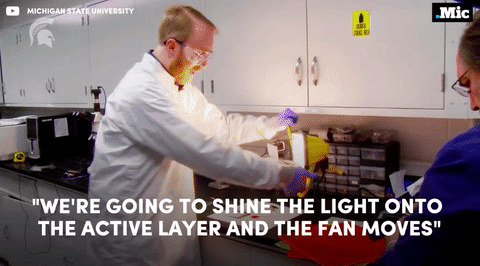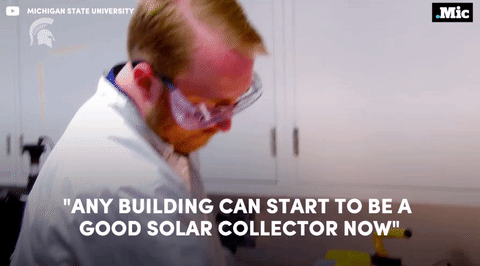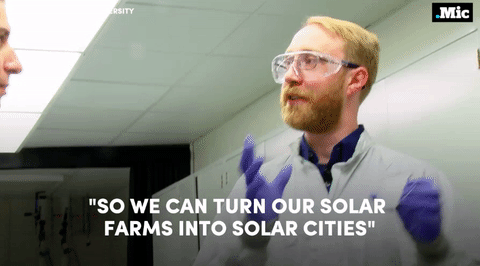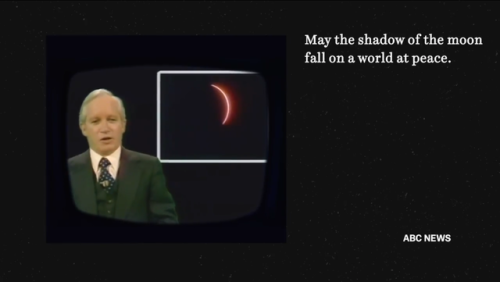Everyone Knows That, In Space, No One Can Hear You Scream. Sound Is A Wave That Requires A Medium To
Everyone knows that, in space, no one can hear you scream. Sound is a wave that requires a medium to travel through, and if space is empty, there’s no medium to carry that sound. Except, as Mike from The Point Studios explains, empty is a relative term. Space is full of dust and gas and plasma, just not as full of that matter as we’re used to. Thus, the question of whether sound can travel through space turns into a matter of scale. If the scale–the wavelength–of a sound is much larger than the distance between molecules, then the sound can propagate. So there CAN be sound in space – it just has to have a very long wavelength and, thus, a very low frequency. Check out the video for the full story! (Video credit: The Point Studios)
More Posts from Maevetheeuropan and Others

GUYS https://twitter.com/AltNatParkSer/status/824054953404669953 http://www.scientistsmarchonwashington.com/ THE NATIONAL PARK SERVICE IS IN OPEN REBELLION

That looks pretty damn cool.
(via The World’s First ‘Marschitect’ Is Laying the Groundwork for Architecture in Space — How We Get To Next)










this is a massive step forward for renewable energy (x) | follow @the-future-now
Kate Rubins’ Space Station Science Scrapbook
As a child, Kate Rubins dreamed of being an astronaut and a scientist. During the past four months aboard the International Space Station, that dream came full circle. She became the first person to sequence DNA in space, among other research during her recent mission, adding to her already impressive experience. She holds a doctorate in molecular biology, and previously led a lab of 14 researchers studying viruses, including Ebola.

Here’s a look back at Rubins in her element, conducting research aboard your orbiting laboratory.
Kate inside Destiny, the U.S. Laboratory Module
The U.S. national laboratory, called Destiny, is the primary research laboratory for U.S. payloads, supporting a wide range of experiments and studies contributing to health, safety, and quality of life for people all over the world.

Destiny houses the Microgravity Science Glovebox (MSG), in which Kate worked on the Heart Cells experiment.
Swabbing for Surface Samples
Microbes that can cause illness could present problems for current and future long duration space missions.

Understanding what microbe communities thrive in space habitats could help researchers design antimicrobial technology. Here, Kate is sampling various surfaces of the Kibo module for the Microbe-IV investigation.
Culturing Beating Heart Cells in Space
The Heart Cells investigation uses human skin cells that are induced to become stem cells, which can then differentiate into any type of cell.

Researchers forced the stem cells to grow into human heart cells, which Rubins cultured aboard the space station for one month.

Rubins described seeing the heart cells beat for the first time as “pretty amazing. First of all, there’s a few things that have made me gasp out loud up on board the [space] station. Seeing the planet was one of them, but I gotta say, getting these cells in focus and watching heart cells actually beat has been another pretty big one.”
Innovative Applied Research Experiment from Eli Lilly
The Hard to Wet Surfaces investigation from Eli Lilly, and sponsored by the Center for the Advancement of Science in Space (CASIS), looks at liquid-solid interactions and how certain pharmaceuticals dissolve, which may lead to more potent and effective medicines in space and on Earth.

Rubins set up vials into which she injected buffer solutions and then set up photography to track how tablets dissolved in the solution in microgravity.
Capturing Dragon
Rubins assisted in the capture of the SpaceX Dragon cargo spacecraft in July. The ninth SpaceX resupply mission delivered more than two thousand pounds of science to the space station.

Biological samples and additional research were returned on the Dragon spacecraft more than a month later.
Sliding Science Outside the Station
Science doesn’t just happen inside the space station. External Earth and space science hardware platforms are located at various places along the outside of the orbiting laboratory.

The Japanese Experiment Module airlock can be used to access the JEM Exposed Facility. Rubins installed the JEM ORU Transfer Interface (JOTI) on the JEM airlock sliding table used to install investigations on the exterior of the orbiting laboratory.
Installing Optical Diagnostic Instrument in the MSG
Rubins installed an optical diagnostic instrument in the Microgravity Science Glovebox (MSG) as part of the Selective Optical Diagnostics Instrument (SODI-DCMIX) investigation. Molecules in fluids and gases constantly move and collide.

When temperature differences cause that movement, called the Soret effect, scientists can track it by measuring changes in the temperature and movement of mass in the absence of gravity. Because the Soret effect occurs in underground oil reservoirs, the results of this investigation could help us better understand such reservoirs.
The Sequencing of DNA in Space
When Rubins’ expedition began, DNA had never been sequenced in space. Within just a few weeks, she and the Biomolecule Sequencer team had sequenced their one billionth “base” – the unit of DNA - aboard the orbiting laboratory.

The Biomolecule Sequencer investigation seeks to demonstrate that DNA sequencing in microgravity is possible, and adds to the suite of genomics capabilities aboard the space station.
Studying Fluidic Dynamics with SPHERES
The SPHERES-Slosh investigation examines the way liquids move inside containers in a microgravity environment. The phenomena and mechanics associated with such liquid movement are still not well understood and are very different than our common experiences with a cup of coffee on Earth.

Rockets deliver satellites to space using liquid fuels as a power source, and this investigation plans to improve our understanding of how propellants within rockets behave in order to increase the safety and efficiency of future vehicle designs. Rubins conducted a series of SPHERES-Slosh runs during her mission.
Retrieving Science Samples for Their Return to Earth
Precious science samples like blood, urine and saliva are collected from crew members throughout their missions aboard the orbiting laboratory.

They are stored in the Minus Eighty-Degree Laboratory Freezer for ISS (MELFI) until they are ready to return to Earth aboard a Soyuz or SpaceX Dragon vehicle.
Measuring Gene Expression of Biological Specimens in Space
Our WetLab-2 hardware system is bringing to the space station the technology to measure gene expression of biological specimens in space, and to transmit the results to researchers on Earth at the speed of light.

Rubins ran several WetLab-2 RNA SmartCycler sessions during her mission.
Studying the First Expandable Habitat Module on the Space Station
The Bigelow Expandable Activity Module (BEAM) is the first expandable habitat to be installed on the space station. It was expanded on May 28, 2016.

Expandable habitats are designed to take up less room on a spacecraft, but provide greater volume for living and working in space once expanded. Rubins conducted several evaluations inside BEAM, including air and surface sampling.
Better Breathing in Space and Back on Earth
Airway Monitoring, an investigation from ESA (the European Space Agency), uses the U.S. airlock as a hypobaric facility for performing science. Utilizing the U.S. airlock allows unique opportunities for the study of gravity, ambient pressure interactions, and their effect on the human body.

This investigation studies the occurrence and indicators of airway inflammation in crew members, using ultra-sensitive gas analyzers to evaluate exhaled air. This could not only help in spaceflight diagnostics, but that also hold applications on earth within diagnostics of similar conditions, for example monitoring of asthma.
Hot Science with Cool Flames
Fire behaves differently in space, where buoyant forces are removed. Studying combustion in microgravity can increase scientists’ fundamental understanding of the process, which could lead to improvement of fire detection and suppression systems in space and on Earth.

Many combustion experiments are performed in the Combustion Integration Rack (CIR) aboard the space station. Rubins replaced two Multi-user Droplet Combustion Apparatus (MDCA) Igniter Tips as part of the CIR igniter replacement operations.
Though Rubins is back on Earth, science aboard the space station continues, and innovative investigations that seek to benefit humans on Earth and further our exploration of the solar system are ongoing. Follow @ISS_Research to keep up with the science happening aboard your orbiting laboratory.
Make sure to follow us on Tumblr for your regular dose of space: http://nasa.tumblr.com
Save Science
Not sure what to say. I’m actually legitimately nervous the Cheeto-in-Chief will demand a hold on the National Science Foundation grants like he did the EPA (disclaimer, the NSF is where my job comes from).
I feel so terrible for all the scientists and students who are now out of the job
SpaceX Sends Super Science to Space Station!
SpaceX is scheduled to launch its Dragon spacecraft PACKED with super cool research and technology to the International Space Station June 1 from Kennedy Space Center in Florida. New solar panels, investigations that study neutron stars and even fruit flies are on the cargo list. Let’s take a look at what other bits of science are making their way to the orbiting laboratory 250 miles above the Earth…

New solar panels to test concept for more efficient power source
Solar panels generate power well, but they can be delicate and large when used to power a spacecraft or satellites. This technology demonstration is a solar panel concept that is lighter and stores more compactly for launch than the solar panels currently in use.

Roll-Out Solar Array (ROSA) has solar cells on a flexible blanket and a framework that rolls out like a tape measure and snap into place, and could be used to power future space vehicles.
Investigation to Study Composition of Neutron Stars
Neutron stars, the glowing cinders left behind when massive stars explode as supernovas, contain exotic states of matter that are impossible to replicate in any lab. NICER studies the makeup of these stars, and could provide new insight into their nature and super weird behavior.

Neutron stars emit X-ray radiation, enabling the NICER technology to observe and record information about its structure, dynamics and energetics.
Experiment to Study Effect of New Drug on Bone Loss
When people and animals spend lots of space, they experience bone density loss. In-flight exercise can prevent it from getting worse, but there isn’t a therapy on Earth or in space that can restore bone that is already lost.

The Systemic Therapy of NELL-1 for osteoporosis (Rodent Research-5) investigation tests a new drug that can both rebuild bone and block further bone loss, improving health for crew members.
Research to Understand Cardiovascular Changes
Exposure to reduced gravity environments can result in cardiovascular changes such as fluid shifts, changes in total blood volume, heartbeat and heart rhythm irregularities, and diminished aerobic capacity.

The Fruit Fly Lab-02 study will use the fruit fly (Drosophila melanogaster) to better understand the underlying mechanisms responsible for the adverse effects of prolonged exposure to microgravity on the heart. Fruit flies are effective model organisms, and we don’t mean on the fashion runway. Want to see how 1,000 bottles of fruit flies were prepared to go to space? Check THIS out.
Space Life-Support Investigation
Currently, the life-support systems aboard the space station require special equipment to separate liquids and gases. This technology utilizes rotating and moving parts that, if broken or otherwise compromised, could cause contamination aboard the station.

The Capillary Structures investigation studies a new method of water recycling and carbon dioxide removal using structures designed in specific shapes to manage fluid and gas mixtures.
Earth-Observation Tools
Orbiting approximately 250 miles above the Earth’s surface, the space station provides pretty amazing views of the Earth. The Multiple User System for Earth Sensing (MUSES) facility hosts Earth-viewing instruments such as high-resolution digital cameras, hyperspectral imagers, and provides precision pointing and other accommodations.

This investigation can produce data that could be used for maritime domain awareness, agricultural awareness, food security, disaster response, air quality, oil and gas exploration and fire detection.
Watch the launch live HERE! For all things space station science, follow @ISS_Research on Twitter.
Make sure to follow us on Tumblr for your regular dose of space: http://nasa.tumblr.com
Getting to Mars: What It’ll Take
Join us as we take a closer look at the next steps in our journey to the Red Planet:
The journey to Mars crosses three thresholds, each with increasing challenges as humans move farther from Earth. We’re managing these challenges by developing and demonstrating capabilities in incremental steps:
Earth Reliant

Earth Reliant exploration is focused on research aboard the International Space Station. From this world-class microgravity laboratory, we are testing technologies and advancing human health and performance research that will enable deep space, long duration missions.
On the space station, we are advancing human health and behavioral research for Mars-class missions. We are pushing the state-of-the-art life support systems, printing 3-D parts and analyzing material handling techniques.
Proving Ground

In the Proving Ground, we will learn to conduct complex operations in a deep space environment that allows crews to return to Earth in a matter of days. Primarily operating in cislunar space (the volume of space around the moon). We will advance and validate the capabilities required for humans to live and work at distances much farther away from our home planet…such as at Mars.
Earth Independent

Earth Independent activities build on what we learn on the space station and in deep space to enable human missions to the Mars vicinity, possibly to low-Mars orbit or one of the Martian moons, and eventually the Martian surface. Future Mars missions will represent a collaborative effort between us and our partners.

Did you know….that through our robotic missions, we have already been on and around Mars for 40 years! Taking nearly every opportunity to send orbiters, landers and rovers with increasingly complex experiments and sensing systems. These orbiters and rovers have returned vital data about the Martian environment, helping us understand what challenges we may face and resources we may encounter.

Through the Asteroid Redirect Mission (ARM), we will demonstrate an advanced solar electric propulsion capability that will be a critical component of our journey to Mars. ARM will also provide an unprecedented opportunity for us to validate new spacewalk and sample handling techniques as astronauts investigate several tons of an asteroid boulder.
Living and working in space require accepting risks – and the journey to Mars is worth the risks. A new and powerful space transportation system is key to the journey, but we will also need to learn new ways of operating in space.
We Need You!

In the future, Mars will need all kinds of explorers, farmers, surveyors, teachers…but most of all YOU! As we overcome the challenges associated with traveling to deep space, we will still need the next generation of explorers to join us on this journey. Come with us on the journey to Mars as we explore with robots and send humans there one day.
Join us as we go behind-the-scenes:
We’re offering a behind-the-scenes look Thursday, Aug. 18 at our journey to Mars. Join us for the following events:
Journey to Mars Televised Event at 9:30 a.m. EDT Join in as we host a conversation about the numerous efforts enabling exploration of the Red Planet. Use #askNASA to ask your questions! Tune in HERE.
Facebook Live at 1:30 p.m. EDT Join in as we showcase the work and exhibits at our Michoud Assembly Facility. Participate HERE.
Hot Fire Test of an RS-25 Engine at 6 p.m. EDT The 7.5-minute test is part of a series of tests designed to put the upgraded former space shuttle engines through the rigorous temperature and pressure conditions they will experience during a launch. Watch HERE.
Make sure to follow us on Tumblr for your regular dose of space: http://nasa.tumblr.com


Solar System: Things to Know This Week
Reaching out into space yields benefits on Earth. Many of these have practical applications — but there’s something more than that. Call it inspiration, perhaps, what photographer Ansel Adams referred to as nature’s “endless prospect of magic and wonder."
Our ongoing exploration of the solar system has yielded more than a few magical images. Why not keep some of them close by to inspire your own explorations? This week, we offer 10 planetary photos suitable for wallpapers on your desktop or phone. Find many more in our galleries. These images were the result of audacious expeditions into deep space; as author Edward Abbey said, "May your trails be crooked, winding, lonesome, dangerous, leading to the most amazing view.”

1. Martian Selfie
This self-portrait of NASA’s Curiosity Mars rover shows the robotic geologist in the “Murray Buttes” area on lower Mount Sharp. Key features on the skyline of this panorama are the dark mesa called “M12” to the left of the rover’s mast and pale, upper Mount Sharp to the right of the mast. The top of M12 stands about 23 feet (7 meters) above the base of the sloping piles of rocks just behind Curiosity. The scene combines approximately 60 images taken by the Mars Hand Lens Imager, or MAHLI, camera at the end of the rover’s robotic arm. Most of the component images were taken on September 17, 2016.
800 x 600
1024 x 768
1280 x 1024
1600 x 1200
1280 x 800
1440 x 900
1920 x 1200

2. The Colors of Pluto
NASA’s New Horizons spacecraft captured this high-resolution, enhanced color view of Pluto on July 14, 2015. The image combines blue, red and infrared images taken by the Ralph/Multispectral Visual Imaging Camera (MVIC). Pluto’s surface sports a remarkable range of subtle colors, enhanced in this view to a rainbow of pale blues, yellows, oranges, and deep reds. Many landforms have their own distinct colors, telling a complex geological and climatological story that scientists have only just begun to decode.
800 x 600
1024 x 768
1280 x 1024
1600 x 1200
1280 x 800
1440 x 900
1920 x 1200

3. The Day the Earth Smiled
On July 19, 2013, in an event celebrated the world over, our Cassini spacecraft slipped into Saturn’s shadow and turned to image the planet, seven of its moons, its inner rings — and, in the background, our home planet, Earth. This mosaic is special as it marks the third time our home planet was imaged from the outer solar system; the second time it was imaged by Cassini from Saturn’s orbit, the first time ever that inhabitants of Earth were made aware in advance that their photo would be taken from such a great distance.
800 x 600
1024 x 768
1280 x 1024
1600 x 1200
1280 x 800
1440 x 900
1920 x 1200

4. Looking Back
Before leaving the Pluto system forever, New Horizons turned back to see Pluto backlit by the sun. The small world’s haze layer shows its blue color in this picture. The high-altitude haze is thought to be similar in nature to that seen at Saturn’s moon Titan. The source of both hazes likely involves sunlight-initiated chemical reactions of nitrogen and methane, leading to relatively small, soot-like particles called tholins. This image was generated by combining information from blue, red and near-infrared images to closely replicate the color a human eye would perceive.
800 x 600
1024 x 768
1280 x 1024
1600 x 1200
1280 x 800
1440 x 900
1920 x 1200

5. Catching Its Own Tail
A huge storm churning through the atmosphere in Saturn’s northern hemisphere overtakes itself as it encircles the planet in this true-color view from Cassini. This picture, captured on February 25, 2011, was taken about 12 weeks after the storm began, and the clouds by this time had formed a tail that wrapped around the planet. The storm is a prodigious source of radio noise, which comes from lightning deep within the planet’s atmosphere.
800 x 600
1024 x 768
1280 x 1024
1600 x 1200
1280 x 800
1440 x 900
1920 x 1200

6. The Great Red Spot
Another massive storm, this time on Jupiter, as seen in this dramatic close-up by Voyager 1 in 1979. The Great Red Spot is much larger than the entire Earth.
800 x 600
1024 x 768
1280 x 1024
1600 x 1200
1280 x 800
1440 x 900
1920 x 1200

7. More Stormy Weather
Jupiter is still just as stormy today, as seen in this recent view from NASA’s Juno spacecraft, when it soared directly over Jupiter’s south pole on February 2, 2017, from an altitude of about 62,800 miles (101,000 kilometers) above the cloud tops. From this unique vantage point we see the terminator (where day meets night) cutting across the Jovian south polar region’s restless, marbled atmosphere with the south pole itself approximately in the center of that border. This image was processed by citizen scientist John Landino. This enhanced color version highlights the bright high clouds and numerous meandering oval storms.
800 x 600
1024 x 768
1280 x 1024
1600 x 1200
1280 x 800
1440 x 900
1920 x 1200

8. X-Ray Vision
X-rays stream off the sun in this image showing observations from by our Nuclear Spectroscopic Telescope Array, or NuSTAR, overlaid on a picture taken by our Solar Dynamics Observatory (SDO). The NuSTAR data, seen in green and blue, reveal solar high-energy emission. The high-energy X-rays come from gas heated to above 3 million degrees. The red channel represents ultraviolet light captured by SDO, and shows the presence of lower-temperature material in the solar atmosphere at 1 million degrees.
800 x 600
1024 x 768
1280 x 1024
1600 x 1200
1280 x 800
1440 x 900
1920 x 1200

9. One Space Robot Photographs Another
This image from NASA’s Mars Reconnaissance Orbiter shows Victoria crater, near the equator of Mars. The crater is approximately half a mile (800 meters) in diameter. It has a distinctive scalloped shape to its rim, caused by erosion and downhill movement of crater wall material. Since January 2004, the Mars Exploration Rover Opportunity has been operating in the region where Victoria crater is found. Five days before this image was taken in October 2006, Opportunity arrived at the rim of the crater after a drive of more than over 5 miles (9 kilometers). The rover can be seen in this image, as a dot at roughly the “ten o'clock” position along the rim of the crater. (You can zoom in on the full-resolution version here.)
800 x 600
1024 x 768
1280 x 1024
1600 x 1200
1280 x 800
1440 x 900
1920 x 1200

10. Night Lights
Last, but far from least, is this remarkable new view of our home planet. Last week, we released new global maps of Earth at night, providing the clearest yet composite view of the patterns of human settlement across our planet. This composite image, one of three new full-hemisphere views, provides a view of the Americas at night from the NASA-NOAA Suomi-NPP satellite. The clouds and sun glint — added here for aesthetic effect — are derived from MODIS instrument land surface and cloud cover products.
Full Earth at night map
Americas at night
Discover more lists of 10 things to know about our solar system HERE.
Make sure to follow us on Tumblr for your regular dose of space: http://nasa.tumblr.com
-
 techjum reblogged this · 4 years ago
techjum reblogged this · 4 years ago -
 tittyhunt liked this · 6 years ago
tittyhunt liked this · 6 years ago -
 maevetheeuropan reblogged this · 8 years ago
maevetheeuropan reblogged this · 8 years ago -
 maevemauvaise reblogged this · 8 years ago
maevemauvaise reblogged this · 8 years ago -
 marigolds01 reblogged this · 8 years ago
marigolds01 reblogged this · 8 years ago -
 marigolds01 liked this · 8 years ago
marigolds01 liked this · 8 years ago -
 ventxekart reblogged this · 8 years ago
ventxekart reblogged this · 8 years ago -
 thegamejustgotmorefierce reblogged this · 8 years ago
thegamejustgotmorefierce reblogged this · 8 years ago -
 jonnyw67-blog liked this · 8 years ago
jonnyw67-blog liked this · 8 years ago -
 warjunky81 liked this · 8 years ago
warjunky81 liked this · 8 years ago -
 sailorhawkmoon liked this · 8 years ago
sailorhawkmoon liked this · 8 years ago -
 wmmeany reblogged this · 8 years ago
wmmeany reblogged this · 8 years ago -
 the-nomadic-writer liked this · 8 years ago
the-nomadic-writer liked this · 8 years ago -
 heyitsameamario liked this · 8 years ago
heyitsameamario liked this · 8 years ago -
 czkavka reblogged this · 8 years ago
czkavka reblogged this · 8 years ago -
 amysontherun reblogged this · 8 years ago
amysontherun reblogged this · 8 years ago -
 sunnyjax342 reblogged this · 8 years ago
sunnyjax342 reblogged this · 8 years ago -
 sunnyjax342 liked this · 8 years ago
sunnyjax342 liked this · 8 years ago -
 vividavis liked this · 8 years ago
vividavis liked this · 8 years ago -
 rgodot liked this · 8 years ago
rgodot liked this · 8 years ago -
 simordentmordetisretro liked this · 8 years ago
simordentmordetisretro liked this · 8 years ago -
 decane101 reblogged this · 8 years ago
decane101 reblogged this · 8 years ago -
 lovetoscience reblogged this · 8 years ago
lovetoscience reblogged this · 8 years ago -
 ahhmedicine reblogged this · 8 years ago
ahhmedicine reblogged this · 8 years ago -
 ahhmedicine liked this · 8 years ago
ahhmedicine liked this · 8 years ago -
 gentianablue reblogged this · 8 years ago
gentianablue reblogged this · 8 years ago -
 notlooking23 liked this · 8 years ago
notlooking23 liked this · 8 years ago -
 blogparanormalexpresso2stuff reblogged this · 8 years ago
blogparanormalexpresso2stuff reblogged this · 8 years ago -
 blogparanormalexpresso2stuff liked this · 8 years ago
blogparanormalexpresso2stuff liked this · 8 years ago -
 baronfelix reblogged this · 8 years ago
baronfelix reblogged this · 8 years ago -
 gummygumballs liked this · 8 years ago
gummygumballs liked this · 8 years ago -
 marshmallowdoritos liked this · 8 years ago
marshmallowdoritos liked this · 8 years ago -
 jaehaerys1 liked this · 8 years ago
jaehaerys1 liked this · 8 years ago -
 nutellaonatoast-blog liked this · 8 years ago
nutellaonatoast-blog liked this · 8 years ago -
 revolutionaryshoe liked this · 8 years ago
revolutionaryshoe liked this · 8 years ago -
 thoughtful-seal-blog liked this · 8 years ago
thoughtful-seal-blog liked this · 8 years ago -
 gentianablue liked this · 8 years ago
gentianablue liked this · 8 years ago




